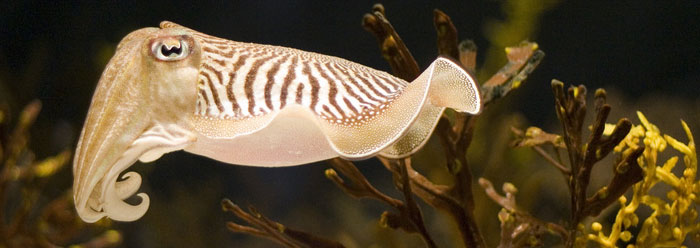Chitin is a biological material found in the cuttlebones, or internal shells, of cuttlefish. It has a maximum shelf life of thousands of years, and yet researchers recently verified—using three separate techniques, multiple laboratories, and careful material handling—that samples of chitin from fossils had the same basic chemistry as modern chitin.
The question they did not answer, however, is why the original organic chitin had not completely fallen apart, which it would have if the fossils with it were 34 million years old, as claimed.
In modern ecosystems, chitin-eating bacteria rapidly recycle the atoms that comprise chitin. So, fossilized chitin must have been quickly isolated from bacteria and water. But how?
Publishing in the online journal PLoS ONE, researchers speculated that the chitin was buried in mud where there was no oxygen and perhaps very few bacteria.1 But multiple experiments have shown that bacteria living in deep mud and without oxygen readily use organic molecules as food sources. For example, one investigator sealed modern lobsters—which have an exoskeleton made of chitin—into jars of water and mud. The result:
Decay processes were active in the experimental conditions despite anoxia [lack of oxygen] and had virtually destroyed the carcasses within 25 weeks.…The results clearly show that anoxia is ineffective as a long-term conservation medium in the preservation of soft-bodied fossils.2
The lobster experiments were performed in fresh water, salt water, and brackish water. And yet despite the lack of oxygen, the lobsters' bodies had decayed in just weeks.
An earlier study had found similar results. Paleontologist Peter Allison sealed small lobsters in different mud-packed jars, opening them at various times. The result was rapid disintegration. He concluded:
Traditionally, stagnation [low oxygen] and rapid burial are considered to be the main prerequisites for the preservation of soft-bodied fossils and the formation of Konservat-Lagerstatten [well-preserved fossils]. Clearly these factors are only important in that they promote early diagenetic [fossil-forming] mineralization. This is the only way to halt information loss through decay.3
In other words, rapid removal from oxygen, water, and bacteria is required for the buried animal's tissues to have a chance to last thousands of years, but mineralization—where tissues are replaced by minerals—is required for tissue impressions to last millions of years. And the PLoS ONE researchers verified that their cuttlebone chitin was not mineralized.
Cuttlebones contain the same kind of chitin as these lobsters, but it is better protected by a mineral casing and should therefore last longer than lobster chitin. Even so, the fossilized cuttlefish in the PLoS ONE study must have been buried rapidly to prevent bacterial degradation, and recently to prevent biochemical decay. Surely, the unfortunate cuttlefish were buried in uniquely catastrophic circumstances that were nothing like modern aquatic ecosystems.
Earlier in 2011, other researchers confirmed original chitin in a Paleozoic scorpion.4 Evolutionary geologists believe that Paleozoic rock layers were deposited hundreds of millions of years ago, but geologists who subscribe to the global Flood described in the Bible attribute them to world-covering wave pulses in the early and middle phases of the Flood year only thousands of years ago.
Because of observed bacterial and biochemical degradation rates, researchers shouldn't expect to find any original chitin (or any other biomolecule) in a sample that is dozens of millions of years old—and it therefore should be utterly absent from samples deposited hundreds of millions of years ago. Thus, the chitin found in these fossils refutes their millions-of-years evolutionary interpretation, just as other fossil biomolecules already have done.5
Evolution cannot explain the presence of original organic material in fossils, but such tissues fit perfectly well with the biblical account of a worldwide flood just thousands of years ago whose unique conditions enabled the rapid burial and fossilization that was needed to preserve the soft-bodied fossils found today.
References
- Weaver, P. G. et al. 2011. Characterization of Organics Consistent with β-Chitin Preserved in the Late Eocene Cuttlefish Mississaepia mississippiensis. PLoS ONE. 6 (11): e28195.
- Boyer, J. N. 1994. Aerobic and anaerobic degradation and mineralization of 14C-chitin by water column and sediment inocula of the York River estuary, Virginia. Applied and Environmental Microbiology. 60 (1): 174-179.
- Allison, P. 1988. The Role of Anoxia in the Decay and Mineralization of Proteinaceous Macro- Fossils. Paleobiology. 14 (2): 139-154.
- Cody, G. D. et al. 2011. Molecular signature of chitin-protein complex in Paleozoic arthropods. Geology. 39 (3): 255-258.
- See Published Reports of Original Soft Tissue Fossils. Institute for Creation Research. Posted on icr.org, accessed December 13, 2011.
* Mr. Thomas is Science Writer at the Institute for Creation Research.
Article posted on December 15, 2011.




